San Francisco Peaks

Thursday, February 11, 2016
Mauna Loa, Hawaii... Not exactly Mustafar
Case Study
Name: Mauna Loa
Location: Hawaii
Type of Volcano: Shield, Caldera
Size: 4,169 m (13,679 ft)
Rock type: Basalt
Hazards: Lava Flows, Gas Emissions, Lava Fountains, Earthquakes, Ground Movement, Vog (Volcanic Smog)
Monitoring: Seismographs, Tiltmeters, GPS
Last Eruption: March 25-April 15, 1984
Current Status: Active
Current Activity: No eruptions, but some seismic activity and ground movement.
Hi,
This week I have been researching the volcano Mauna Loa ("Long Mountain") located on Hawaii Island. Mauna Loa is the largest volcano in the world. It covers more than half the island. It is concerning that this island also has the fastest growing population in Hawaii. Residents are encouraged to learn about the hazards the volcano poses so that they are prepared for eruptions. Unlike Flagstaff, this shield volcano gives evidence of its active status. There are rifts on the volcano, which release gases and sometimes lava.
Mauna Loa is part of the Hawaiian island chain. This volcanic chain was created by a hot spot (a place in the earth's subsurface where magma has risen into mantle) that the Pacific Plate is passing over. While Kilauea is one of the most active volcanoes, Mauna Loa is classified as active and is predicted to have a large eruption within our lifetimes.
The most famous eruption of Mauna Loa occurred in 1984. Scientists started recording an increase in shallow and intermediate earthquakes in 1983 accompanied with an extension of the surface of the volcano. Based on previous eruptions and indicators, they assumed that magma had intruded into the magma chamber, which made the possibility of an eruption more certain.
A satellite detected the volcano's eruption after discovering an unusual infrared signal from the volcano. The eruption consisted of a lava fountain (seen below), venting at the rifts, the creation of new rifts, and lava flows. The flow was especially dangerous as it advanced towards the town of Hilo, destroying levees meant to check its flow. Luckily the eruption slowed and the lava became stickier, so the town was not damaged; however, it was a reminder of the dangers of living close to an active volcano. Yet, the vog caused by the eruption hung over Hawaii for a while.
Due to the satellite and to the constant monitoring of the volcano, scientists and residents were more prepared for the eruption to occur. In Flagstaff, we aren't as concerned about the hazards our beautiful Peaks and the SFVF pose. This case study illustrates the benefits of monitoring and the unpredictability of volcanoes. Despite the baseline data that scientists had on Mauna Loa, they still could not predict when the volcano would erupt. They could only claim that they thought it would be based on previous behaviour.
Next week we will take a look at another Hawaiian volcano, Kilauea.
An interesting volcanic event this week: Japan's Sakurajima erupted on Sunday (February 7, 2016). The fountain of lava was not just shooting out glowing orange material, but lightning too. It is strangely pretty. To watch a video see http://www.huffingtonpost.com/entry/sakurajima-volcano-lightning_us_56b8016ce4b08069c7a7c782
Chao,
Rachel
Subscribe to:
Post Comments (Atom)


Awesommmeee! Thank you- I now have learned a lot about Mauna Loa. Do scientists know yet of any ways to predict the timing of eruptions, and if so, what are they? Besides levees, what other methods to Hawaiians use to protect themselves from volcanic damage?
ReplyDeleteTiming of eruptions as in when it will occur or how long will it last because those are very different questions and answers. I have only read about levees being used as well as making people aware of the hazards so education. If I find more protective measures I will talk about it later when I discuss how Flagstaff should protect itself if there was renewed volcanism.
DeleteI think to properly research this, a trip to Hawaii is in order.
ReplyDelete